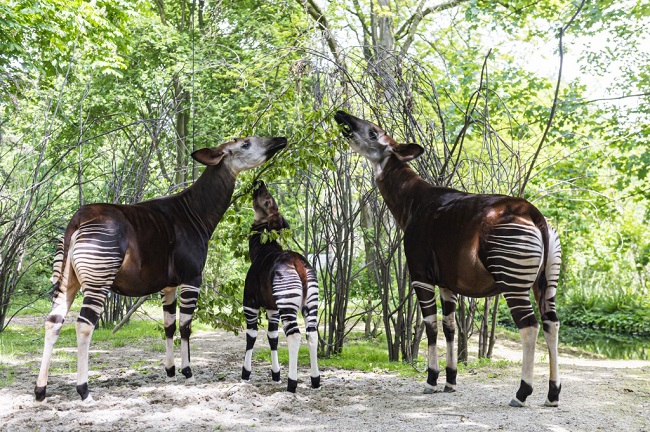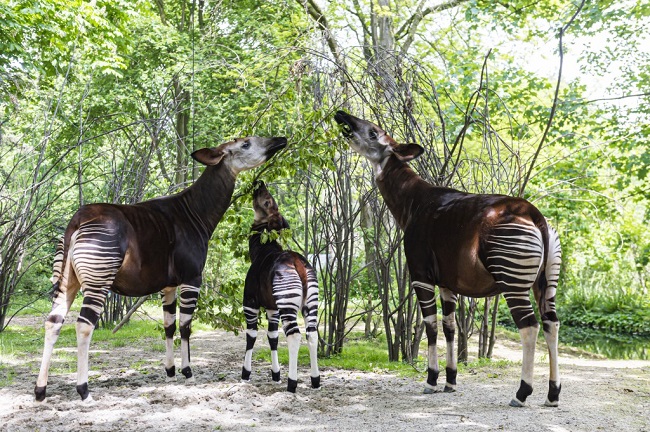A rainforest is an area that consists of tall, evergreen trees and a high amount of rainfall. It’s one of the oldest living ecosystems on earth. It has highly complex and diverse biodiversity. Rainforests include almost 80% of the terrestrial ecosystem.
It is interesting to note that the rainforests are responsible for 28% of the world’s oxygen. However, it’s very sad that these endemic rainforests are quickly disappearing due to deforestation and pollution of the atmosphere.

What Defines Rainforest Animals?
Rainforest animals are characterized by their adaptations to the warm, humid, and dense environment of the forests.
These adaptations include vibrant colors, keen senses, and unique feeding habits, all of which enable them to survive and thrive in the competitive rainforest ecosystem.
From the stealthy jaguars to the industrious leaf-cutter ants, each species plays a critical role in the forest’s complex web of life.
Read Also:
Top 16 Amazing Rainforest Animals
A wide variety of animal life is found in this type of forest. They are mostly lemurs, sloths, toucans, parrots, gorillas etc. Let’s look into some of the animals inhabiting it. Here’s a list of the top 16 amazing animals of rainforests.
1. Mountain Gorilla
It is one of the subspecies of the eastern gorilla. Mountain gorillas are actually the largest living primates on earth.
They are a descendant of the ancestral monkeys and apes which were found in Africa and are closely related to chimpanzees, orangutans, and humans. They inhabit the mountainsides of national parks in Rwanda, Uganda, and the Democratic Republic of Congo in Central Africa.
2. Blue Morpho Butterfly
The Blue Morpho butterfly is a brightly colored species of butterfly which is primarily found in the tropical forests of Central and South America. As the name suggests, the wings are blue in color with black edges.
There are many “eyespots” on the brown underside of the wing which fools the predators into thinking the butterfly is a large predator and not something to be messed with.
3. Okapi
It is also known as the forest giraffe. Okapi has striped markings on its body, resembling that of a zebra. But they are actually related more closely to a giraffe. Okapi lives in the dense tropical forest of Central Africa.
4. Brown-Throated Three-Toed Sloth
Sloths are one of the slowest animals on earth. They spend most of their lives hanging upside down or latched onto a tree in tropical rainforests of South America and Central America. They weigh about 8-9 pounds and feed on leaves, twigs, and fruits.
5. Jaguar
It’s a large feline species that has a beautiful, spotted fur coat that helps them to camouflage themselves against the grasses, bushes, and trees. Jaguars prey on almost 85 species.
This species range across Central America to the south of Paraguay and northern Argentina.It inhabits mostly forested and open terrains, but it prefers to live in a tropical or subtropical moist forest and wetlands.
6. Capybara
They strongly resemble a guinea pig and it’s actually the largest rodent on earth. It is more than 100 pounds in weight and at least 2 feet tall. Capybara lives in the Savannas and dense vegetation that is surrounded by water bodies. It is native to South America.
They are highly social animals that live among groups. This large rodent is herbivorous and mainly feeds on grasses and aquatic plants. The most interesting fact is that this animal can hold its breath for 5 minutes underwater.
7. Scarlet Macaw
It is one of the most famous animals that could be found in rainforests. They are large red, yellow, and bluebirds native to Central and South America. The Scarlet Macaw is one of the members of Neotropical parrots, commonly known as macaws.
This large parrot has a striking red plumage, blue and yellow feathers in its wings. Macaws have a powerful beak that helps them break open the hard nuts. They feed on insects, bugs, snails, and also flowers and nectars. One interesting fact is that they mate for life.
8. Black Howler Monkey
These South American monkeys are a very loud terrestrial animal and are one of the largest and most abundant primates in the rainforests. They create a loud howling noise to mark their territory. Howler monkeys have an interesting trait called sexual dimorphism where the males have black fur coats while the females are blonde.
They have a prehensile tail which helps them for locomotion as they move from trees to trees. These black howler monkeys live in the tall trees of the rainforests. They are a social group of animals that travel and live together in groups of 4 to 19.
9. Sulawesi Bear Cuscus
It’s a species of arboreal marsupial endemic to Sulawesi and islands of Indonesia. It resembles a bear. This bear phalanger mostly lives in tropical and moist forests. They are diurnal and feed on leaves. It is seen that they are found in pairs.
Like other marsupials such as a kangaroo, the female bear cuscus gives birth to an underdeveloped offspring and lets the offspring stay in a pouch on her belly for about eight months till the baby is developed sufficiently for survival.
10. Green Anaconda
It is also known as the common water boa and is one of the largest snakes in the world. It can grow up to 30 feet in length and weigh about 500 pounds. The green anaconda is a type of boa species that is native to South America.
It might be scary-looking but it is actually a non-venomous boa constrictor. Due to their size, they are quite slow inland but very swift underwater. They mostly inhabit the swamps and marshes.
Their color pattern is olive green with black spots throughout their body. Green anacondas are nocturnal, primarily aquatic and feed on birds, fish, mammals, and other reptiles.
11. Harpy Eagle (Harpia harpyja)
- Habitat: These powerful birds inhabit the tropical rainforests of Central and South America.
- Diet: They hunt medium-sized mammals like monkeys and sloths.
- Interesting Fact: Harpy eagles have the largest talons of any eagle, which can reach up to 5 inches long.
12. Poison Dart Frog (Dendrobatidae family)
- Habitat: Found in the rainforests of Central and South America.
- Diet: They primarily eat ants, termites, and other small insects.
- Interesting Fact: Their bright colors serve as a warning to predators about their toxicity.
13. Capuchin Monkey (Cebinae subfamily)
- Habitat: Found in the rainforests of Central and South America.
- Diet: Omnivorous, eating fruits, insects, small birds, and amphibians.
- Interesting Fact: Capuchins are known for their intelligence and use of tools.
14. Red-Eyed Tree Frog (Agalychnis callidryas)
- Habitat: Native to the rainforests of Central America.
- Diet: Insects and other small invertebrates.
- Interesting Fact: Their bright red eyes can startle predators, giving them a chance to escape.
15. Tamarin (Saguinus)
- Habitat: Found in the rainforests of Central and South America.
- Diet: Omnivorous, eating fruits, flowers, nectar, and small animals.
- Interesting Fact: Tamarins are known for their social behavior and often live in family groups.
16. Goliath Bird-Eating Spider (Theraphosa blondi)
- Habitat: Inhabit the rainforests of South America, particularly in Brazil and Venezuela.
- Diet: Mainly insects, but can also prey on small birds, rodents, and reptiles.
- Interesting Fact: Despite its name, this spider rarely eats birds.
Examples of Iconic Rainforest Animals
The Amazon Rainforest alone is home to an estimated 10% of the world’s known species. Iconic animals include the jaguar, the apex predator of the Americas; the toucan, with its distinctive colorful beak; and the red-eyed tree frog, known for its striking appearance.
The Borneo rainforest hosts the endangered orangutan, while the Congo Basin is the habitat of the elusive gorilla.
Each of these species not only adds to the biodiversity but also plays a vital role in maintaining the ecological balance.
Threats to Rainforest Wildlife
Unfortunately, rainforest animals face numerous threats, primarily due to human activities. Deforestation, driven by logging, agriculture, and urbanization, destroys their habitats. Poaching and the illegal wildlife trade further threaten many species.
Climate change is altering rainforests, impacting the availability of food and shelter. Conservation efforts are crucial to protect these animals and their habitats.
Conservation Efforts
Conservationists are working tirelessly to protect rainforest animals. Efforts include establishing protected areas, enforcing anti-poaching laws, and promoting sustainable land-use practices.
Rehabilitation and breeding programs are helping to revive endangered species populations.
Additionally, educating the public about the importance of rainforests and the wildlife they support is crucial for long-term conservation success.
Habitats of Rainforest Animals
Rainforest animals inhabit various layers of the rainforest, each offering different resources and challenges:
- Emergent Layer: The tallest trees, where birds and insects thrive.
- Canopy Layer: Dense layer of trees that house many birds, monkeys, and insects.
- Understory Layer: Smaller trees and shrubs where reptiles, amphibians, and insects are common.
- Forest Floor: Dark, damp ground layer inhabited by large mammals, insects, and decomposers.
What Do Rainforest Animals Eat?
Rainforest animals have diverse diets:
- Carnivores: Jaguars, harpy eagles, green anacondas.
- Herbivores: Three-toed sloths, okapis.
- Omnivores: Capuchin monkeys, tamarins.
- Insectivores: Poison dart frogs, red-eyed tree frogs.
10 Facts About Rainforest Animals
- High Biodiversity: Rainforests are home to over half of the world’s plant and animal species.
- Camouflage: Many animals have evolved camouflage to blend into their surroundings.
- Nocturnal Habits: Many rainforest animals are nocturnal to avoid daytime predators and heat.
- Arboreal Lifestyle: A significant number of animals live in trees to escape ground predators.
- Mutualism: Some species form mutualistic relationships, such as ants protecting trees that provide them food.
- Specialized Diets: Many animals have specialized diets, like fruit bats that feed on specific fruits.
- Venom and Poison: Several species, like the poison dart frog, have developed toxins for defense.
- Complex Social Structures: Animals like monkeys and tamarins have complex social behaviors and hierarchies.
- Migration: Some species, like certain birds, migrate to and from rainforests depending on the season.
- Endangered Species: Deforestation and habitat loss have put many rainforest species at risk of extinction.
Do All Animals Live in the Rainforest?
Not all animals live in rainforests. Many species are adapted to other habitats such as deserts, savannas, and polar regions. However, rainforests are incredibly diverse and host a large proportion of the world’s species.
How Many Animals Are Killed in the Rainforest?
It’s challenging to quantify the exact number of animals killed in the rainforest due to deforestation and habitat destruction. However, it is estimated that millions of animals lose their lives each year due to these activities.
Main Features of Animals Living in Rainforests
Rainforest animals have adapted to their environment in unique ways:
- Camouflage: Helps them hide from predators or ambush prey.
- Arboreal Adaptations: Many animals have strong limbs and prehensile tails for climbing.
- Nocturnal Behavior: To avoid daytime predators and heat.
- Bright Colors: Often a warning sign of toxicity or used in mating displays.
Read Also:
Conclusion
Uncountable amounts of species live in rainforests, and some are yet to be discovered. Rainforests show the highest diversity of flora and fauna.
It is due to the fact that this type of forest provides a perfect environment with the necessary amount of rainfall and climatic conditions which allow the species to survive well.
So, it’s a must-discuss topic. Hence, we have provided you a list of some of the most famous and iconic animals that can be found in this tropical and moist rainforests. With the help of this article, we hope you learned something new about these animals.




